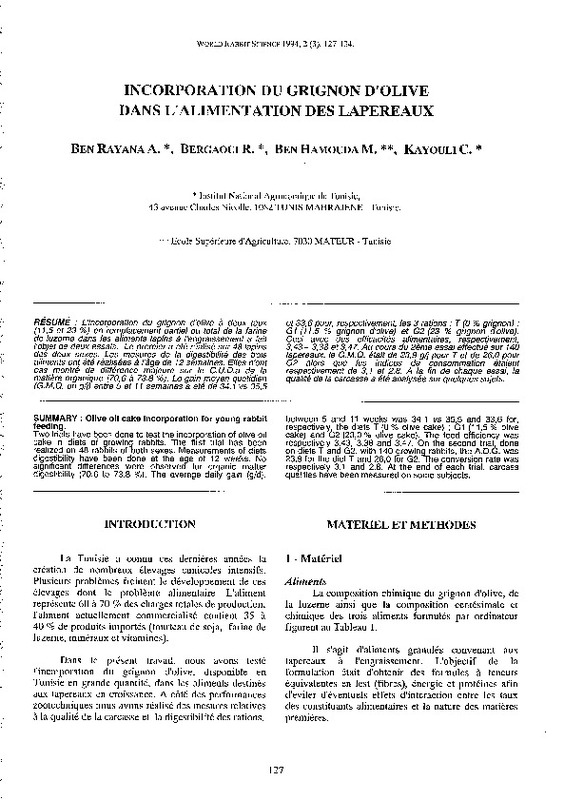JavaScript is disabled for your browser. Some features of this site may not work without it.
Buscar en RiuNet
Listar
Mi cuenta
Estadísticas
Ayuda RiuNet
Admin. UPV
INCORPORATION DU GRIGNON D'OLIVE DANS L'ALIMENTATION DES LAPEREAUX
Mostrar el registro sencillo del ítem
Ficheros en el ítem
| dc.contributor.author | Ben Rayana, A.
|
|
| dc.contributor.author | Bergaoui, R.
|
|
| dc.contributor.author | Ben Hamouda, M.
|
|
| dc.contributor.author | Kayouli, C.
|
|
| dc.date.accessioned | 2011-03-23T10:42:22Z | |
| dc.date.available | 2011-03-23T10:42:22Z | |
| dc.date.issued | 1994 | |
| dc.identifier.issn | 1257-5011 | |
| dc.identifier.uri | http://hdl.handle.net/10251/10532 | |
| dc.description.abstract | [EN] Two trials have been done to test the incorporation of olive oil cake in diets of growing rabbits. The first trial has been realized on 48 rabbits of both sexes. Measurements of diets digestibility have been done at the age of 12 weeks. No significant differences were observecf for organic matter digestibility (70.6 to 73.8 %). The average daiíy gain (g/d), between 5 and 11 weeks was 34, 1 vs 35,5 and 33,6 for, respectively, the diets T (O% olive cake) ; G1 (11,5 % olive cake) and G2 (23,0 % ohve cake). The feed etficiency was respectively 3.43, 3.38 and 3.47. On the second tria!, done on diets T and G2, with 140 growing rabbits, the A.D.G. was 23,9 for the diet T and 26,0 for G2. The conversion rate was respectively 3.1 and 2.8. At the end of each tria!, carcass qualities have been measured on sorne subjects. | |
| dc.description.abstract | [FR] L'incorporation du grignon d'olive a deux taux (11,5 et 23 %) en remplacement partiel ou total de la farine de luzerne dans les aliments lapins a l'enJJraissement a fait l'objet de deux essais. Le premier a été realisé sur 48 lapins des deux sexes. Les mesures de la digestibilité des trois aliments ont été réalisées a l'age de 12 semaines. Elles n'ont pas montré de différence majeure sur le e.u.o.a de la matiere organique (70,6 a 73.8 %). Le gain moyen quotidien (G.M.Q. en g/j) entre 5 et 11 semaines a été de 34, 1 vs 35,5 et 33,6 pour, respectivement, les 3 rations: T (O% grignon); G 1 (11,5 % grignon d'olive) et G2 (23 % grignon d'olive). Ceci avec des efficacités alimentaires, respectivement, 3,43- 3,38 et 3,47. Au cours du 2eme essai effectué sur 140 lapereaux, le G.M.Q. était de 23,9 g/j pour T et de 26,0 pour G2 alors que les indices de consommation étaient respectivement de 3, 1 et 2,8. A la fin de chaque essai, la qualité de la carcasse a été analysée sur quelques sujets. | |
| dc.language | Francés | es_ES |
| dc.publisher | World Rabbit Science. ICTA. UPV | es_ES |
| dc.relation.ispartof | World Rabbit Science | |
| dc.rights | Reserva de todos los derechos | es_ES |
| dc.title | INCORPORATION DU GRIGNON D'OLIVE DANS L'ALIMENTATION DES LAPEREAUX | es_ES |
| dc.type | Artículo | es_ES |
| dc.date.updated | 2011-03-23T08:54:41Z | |
| dc.identifier.doi | 10.4995/wrs.1994.228 | |
| dc.rights.accessRights | Abierto | es_ES |
| dc.description.bibliographicCitation | Ben Rayana, A.; Bergaoui, R.; Ben Hamouda, M.; Kayouli, C. (1994). INCORPORATION DU GRIGNON D'OLIVE DANS L'ALIMENTATION DES LAPEREAUX. World Rabbit Science. 2(3). https://doi.org/10.4995/wrs.1994.228 | es_ES |
| dc.description.accrualMethod | SWORD | es_ES |
| dc.relation.publisherversion | https://doi.org/10.4995/wrs.1994.228 | |
| dc.description.volume | 2 | |
| dc.description.issue | 3 | |
| dc.identifier.eissn | 1989-8886 | es_ES |








